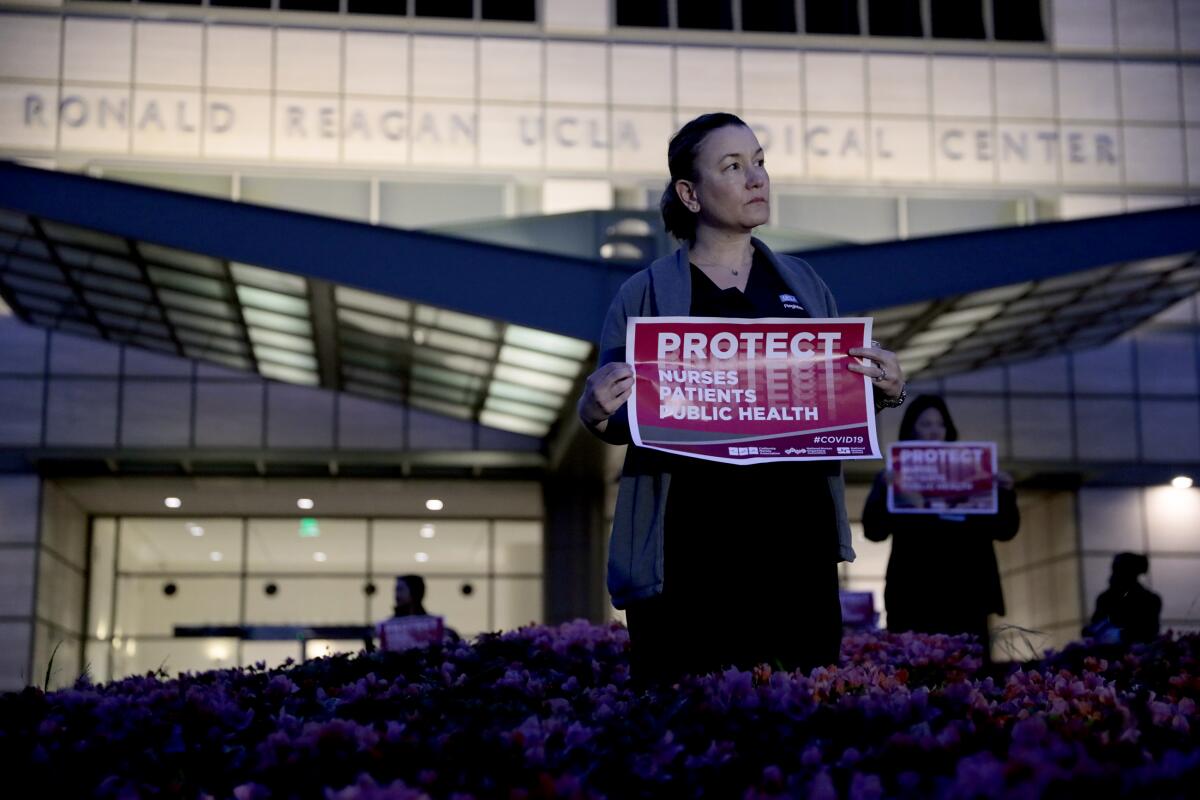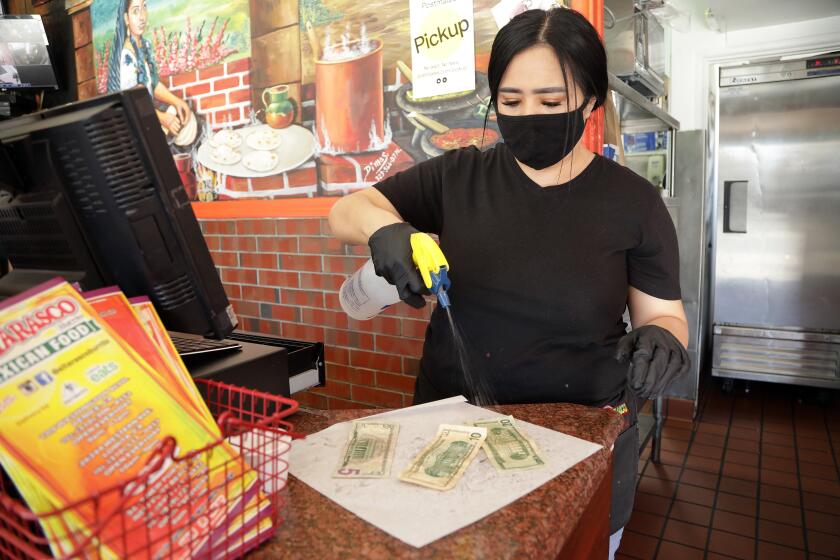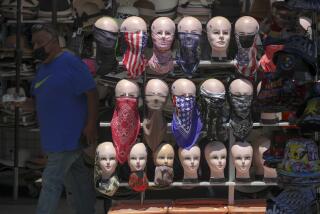Hospitalizations spike as California tries to slow coronavirus spread

While Gov. Gavin Newsom issued an urgent call Monday for retired healthcare workers and students nearing graduation to join in caring for an expected surge of coronavirus patients, officials scrambled to contain a rash of outbreaks in nursing homes and find space for thousands of new hospital beds.
Authorities in Los Angeles County moved to isolate and quarantine patients at 11 assisted living facilities, up from just three on Friday. And nine employees and two patients tested positive at the 780-bed Laguna Honda Hospital and Rehabilitation Center in San Francisco, prompting the Centers for Disease Control and Prevention to send physicians and epidemiologists to manage a potentially devastating outbreak of COVID-19.
Los Angeles County officials listed seven additional deaths from the virus Monday, bringing the total to 44. Six of the seven new victims were 65 or older; the other was between the ages of 41 and 65.
County Public Health Director Barbara Ferrer tallied an additional 342 cases of the virus, bringing the total to 2,474 in the county, including people who have recovered. She said more than 15,500 people have been tested for the novel coronavirus in the county, with 12% showing positive.
To prevent the spread of the virus within its ranks, the Los Angeles Police Department announced it was taking officers’ temperatures as they arrived at shifts and sending anyone with a fever home. So far, 26 employees have tested positive.
“We are taking every step to ensure officers’ health,” Assistant Chief Horace Frank said.
Department roll calls are now conducted with officers spaced far apart, work spaces are frequently sanitized and officers are equipped with N-95 masks, gloves and goggles to use in the field.
Hospitals continue to be the battlefront most in need of reinforcements. Newsom announced an executive order to expand the services medical professionals can perform in their jobs. He said he believes the state can add 37,000 healthcare workers by asking recently retired providers, those in the process of getting a medical license in the state and students enrolled in medical or nursing schools to apply to the newly created California Health Corps.
Newsom’s message to anyone with healthcare experience was clear Monday: “We need you.”
The executive order allows the state Department of Consumer Affairs to waive licensing requirements and change the scope of practice of healthcare professions through June 30.
New York Gov. Andrew Cuomo announced a similar effort last week calling on retired healthcare workers, medical students and mental health workers to sign up to help care for patients, with that initiative drawing 40,000 volunteers.
Newsom said Monday he is hopeful that “with this effort we will see a surge of individuals” who can help in California.
“Other states have issued more specific executive orders regarding extension of license expirations and expanded scope of practice for clinical staff,” said Joanne Spetz, an associate director of research at Healthforce Center at UC San Francisco, which produces supply and demand forecasts on registered nurses in the state. “Until we have more details on which specific requirements are waived by the state agencies, it’s hard to say how much of an impact the executive order will have.”
Over the past four days, the number of intensive care patients in the state has tripled — from 200 to 597 — and the number of hospitalizations has nearly doubled, from 746 to 1,432. The confirmed cases climbed to more than 6,400 and deaths to 142.
Dr. Mark Ghaly, California’s secretary of health and human services, said modeling suggests the state will need 50,000 new hospital beds by mid-May.
“We project that we will need that towards the second half of the month of May,” Ghaly said. “So we are very busy trying to build towards that.”
Newsom said the Army Corps of Engineers is looking at several sites to house 50,000 new beds.
On Sunday, the Navy hospital ship Mercy, which is docked at the Port of Los Angeles, began receiving patients who do not have COVID-19 in an effort to reduce the strain on hospitals treating those who do have the virus.
In San Mateo County, the National Guard was preparing to set up medical cots and equipment at the San Mateo Event Center. The federal treatment site will be able to house 250 patients with mild COVID-19 symptoms.
“The latest projections estimate that a medical surge could push the hospitals in our county to capacity and we’ll need another location to house patients requiring particular levels of care,” County Manager Mike Callagy said. “We can’t just wait to see if this will happen.”
The catastrophic potential is already showing itself in nursing homes, where COVID-19 outbreaks are occurring with terrifying speed across the country.
One of the first hot spots in the U.S. was at the Life Care Center nursing home in Kirkland, Wash., where two-thirds of the residents and 47 workers fell ill, and 37 people died.
Los Angeles Times’ visual coverage of the coronavirus crisis
Los Angeles County released the names of all 11 care homes with outbreaks, including Kensington Assisted Living in Redondo Beach, Alameda Care Center in Burbank and Silverado Beverly Place in Los Angeles. The county defines an outbreak as three or more cases involving residents or staff at a facility.
The county’s Department of Public Health was also investigating reports of at least one suspected coronavirus infection at seven additional nursing homes as of Monday afternoon.
One concern for nursing home administrators and physicians is guidance from federal and some state regulators to accept new residents and those returning from hospitals without proof that they are virus-free.
Families with loved ones in nursing homes should seriously consider pulling them out if it’s at all feasible to care for them at home, said Charlene Harrington, professor emeritus at UC San Francisco’s School of Nursing.
“The risk of exposure is so overwhelming,” said Harrington, who has studied nursing homes since the 1980s. “It’s a terrible concern.”
Times staff writers Joe Mozingo, Harriet Ryan, Richard Winton, Hannah Fry, Alex Wigglesworth, Taryn Luna, Jaclyn Cosgrove and Laura Newberry contributed to this report.
More to Read
Sign up for Essential California
The most important California stories and recommendations in your inbox every morning.
You may occasionally receive promotional content from the Los Angeles Times.
















